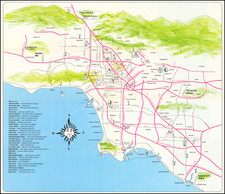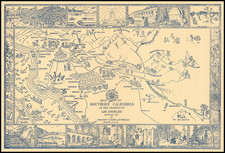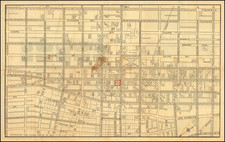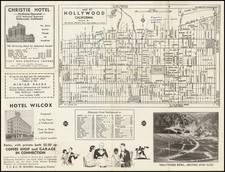The period around 1940 was a time of profound change in Southern California, which is beautifully captured in the Thomas Brothers Street map covering Redondo Beach, Hollywood Riviera, Hermosa Beach, Manhattan Beach, with an inset of Western Torrance.
Redondo Beach: Incorporated in 1892, Redondo Beach started as a port and soon evolved into a popular resort destination. By the 1940s, the map would have depicted landmarks like King Harbor and likely the saltwater plunge, reflecting its reputation as a leisure hub.
Hollywood Riviera: Although a part of Torrance, Hollywood Riviera's distinct charm warranted its spotlight. Named in the 1920s to evoke a blend of Hollywood glamour and French Riviera elegance, this residential area was an alluring blend of beauty and tranquility.
Hermosa Beach: Incorporated in 1907, Hermosa Beach has always been a magnet for those seeking beachside leisure. By the 1940s, it was known for its lively spirit, a haven for the young and vibrant.
Manhattan Beach: Established in 1912, Manhattan Beach echoed a serene, laid-back affluence. The map from the 1940s would have charted its tranquil streets and proximity to the ocean, mirroring its calm essence.
Western Part of Torrance (Inset): Founded in 1912 and driven by its industrial zones, Torrance quickly became a commercial hub neighboring the beach cities. The inset would have portrayed the city's arteries and its intertwining relationship with its coastal neighbors.
This Thomas Brothers map from the 1940s is more than just cartography. It’s a glimpse into the evolving identities of these Southern Californian gems, encapsulating their unique histories and the spirit of a bygone era.
Thomas Brothers and Their Legacy in Mapping
The Thomas Brothers, pioneering cartographers of the 20th century, carved a unique niche in the world of mapmaking with their meticulous street atlases that have since become indispensable resources for countless Americans. The trio's journey began in the bustling hub of Oakland, California, in 1915, where George Coupland Thomas and his two brothers established Thomas Bros. Maps.
Initially, their publications included detailed block maps, birds-eye views of communities, and what one might consider generalized tourist maps. Their emphasis on accuracy, granularity, and user-friendliness quickly set them apart in the growing map industry. By the late 1940s, the brothers expanded their offerings, introducing street guides initially available as pocket-sized booklets. These guides encapsulated regions across several counties in California and even extended to Washington, offering detailed street views and points of interest.
A significant historical footnote is the company's involvement in producing redlining maps for several major Californian cities like Los Angeles, San Francisco, and Sacramento for the US government-sponsored Home Owners' Loan Corporation in the 1930s. These maps, controversial in today's context, played a role in shaping urban development and housing policies of the time.
In 1940, seeking larger opportunities and driven by the company's burgeoning success, the Thomas Brothers relocated their headquarters to Los Angeles. The move coincided with the addition of pocket-sized guidebooks dedicated to California and San Francisco, complete with fold-out maps, further solidifying their dominance in the local market.
Following the death of George Coupland Thomas in 1955, the company witnessed a transition in leadership. Warren B. Wilson, the family lawyer, acquired the business. Under his guidance, Thomas Bros. Maps continued to flourish, adapting to the changing needs of the market and expanding its geographic footprint.
By the onset of the California home development boom in the 1970s, the company's reputation was unparalleled. The transition to Irvine, California, in 1980 under Wilson's directive marked a new era, with the company setting its sights on digital innovations and new markets.












![[ Los Angeles / Harris Newmark ] Newmark Block Junction of Main and Spring Sts., Los Angeles, Cal.](https://storage.googleapis.com/raremaps/img/small/97889.jpg)

![(Southern California - Oxnard to Glendale) [Composite of Eight Topographical Maps]](https://storage.googleapis.com/raremaps/img/small/95921.jpg)

